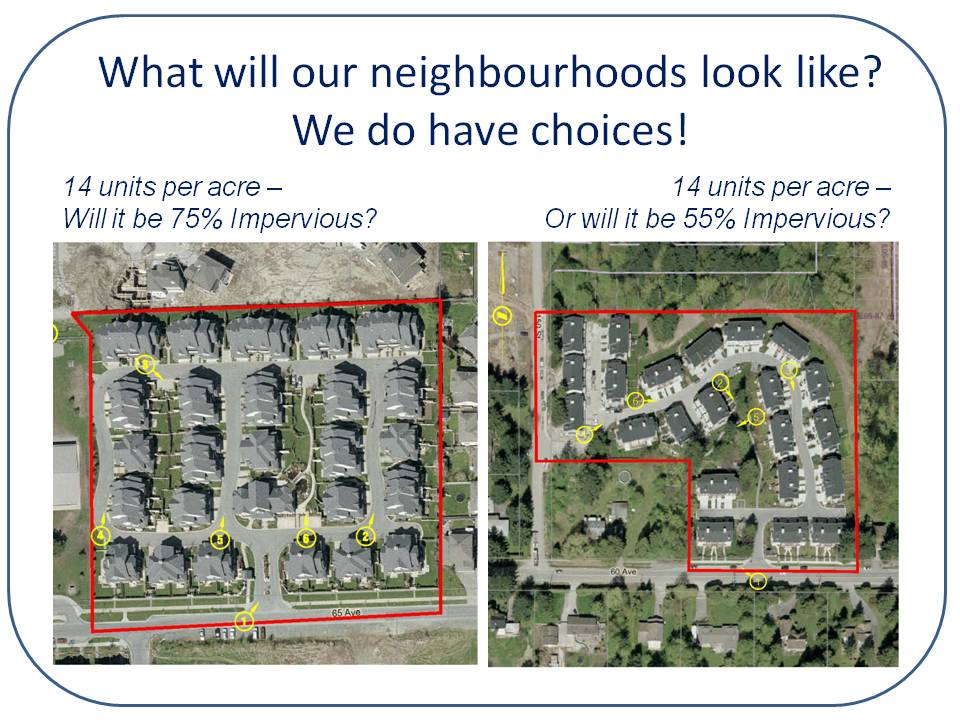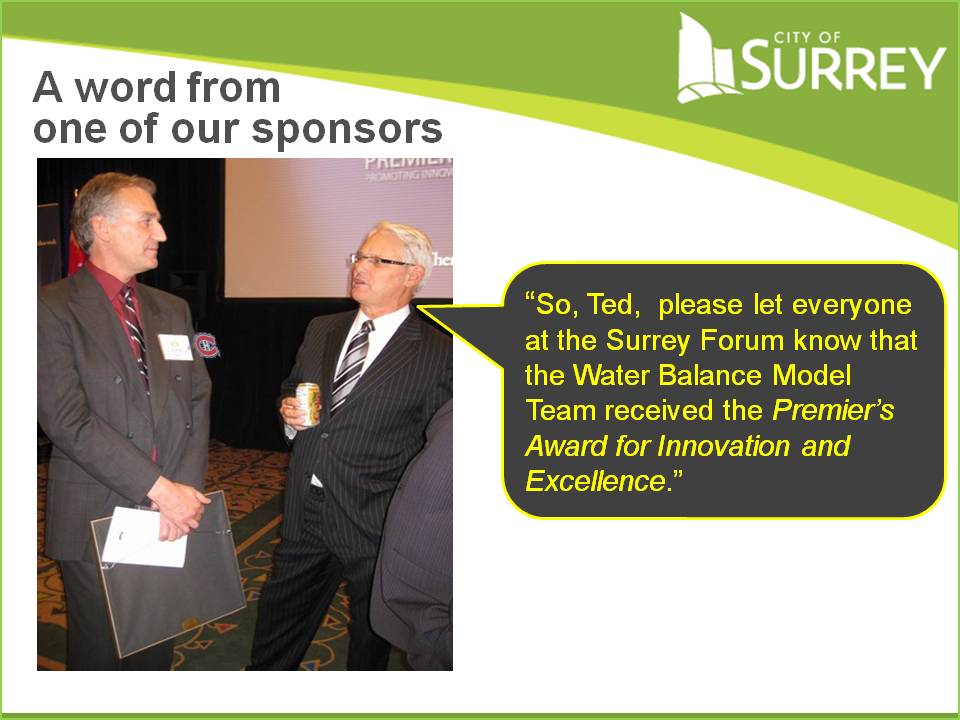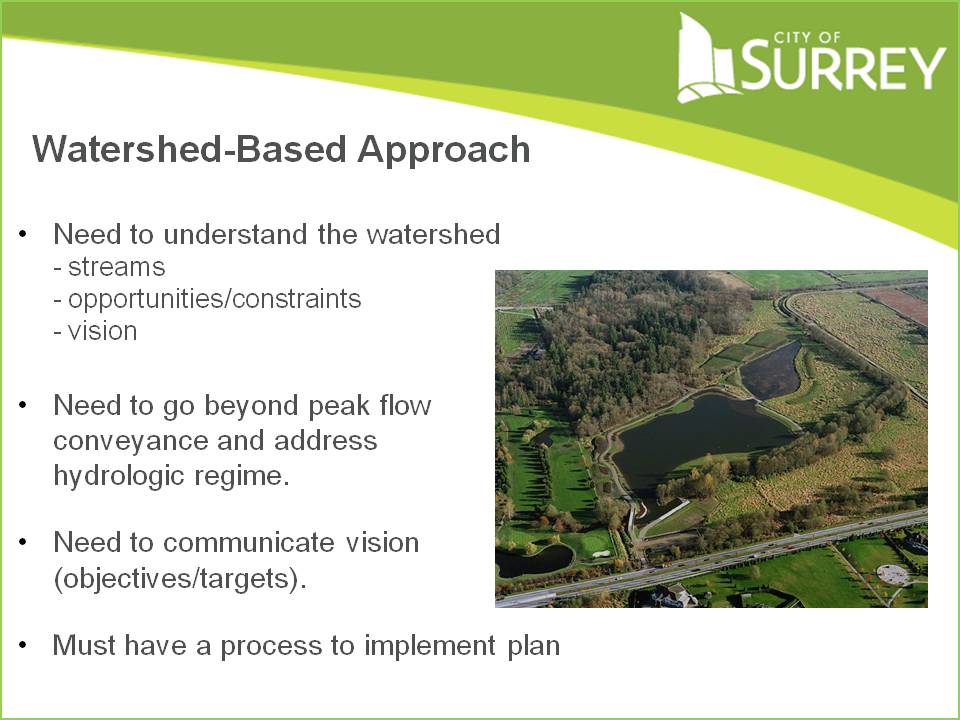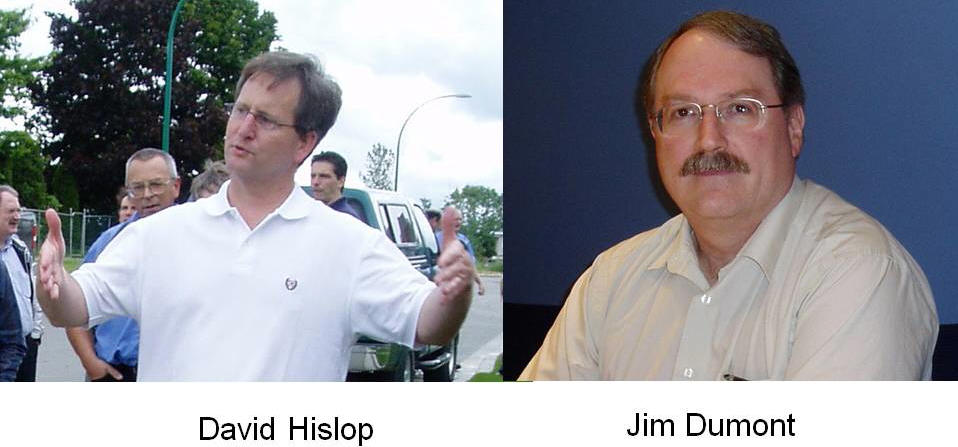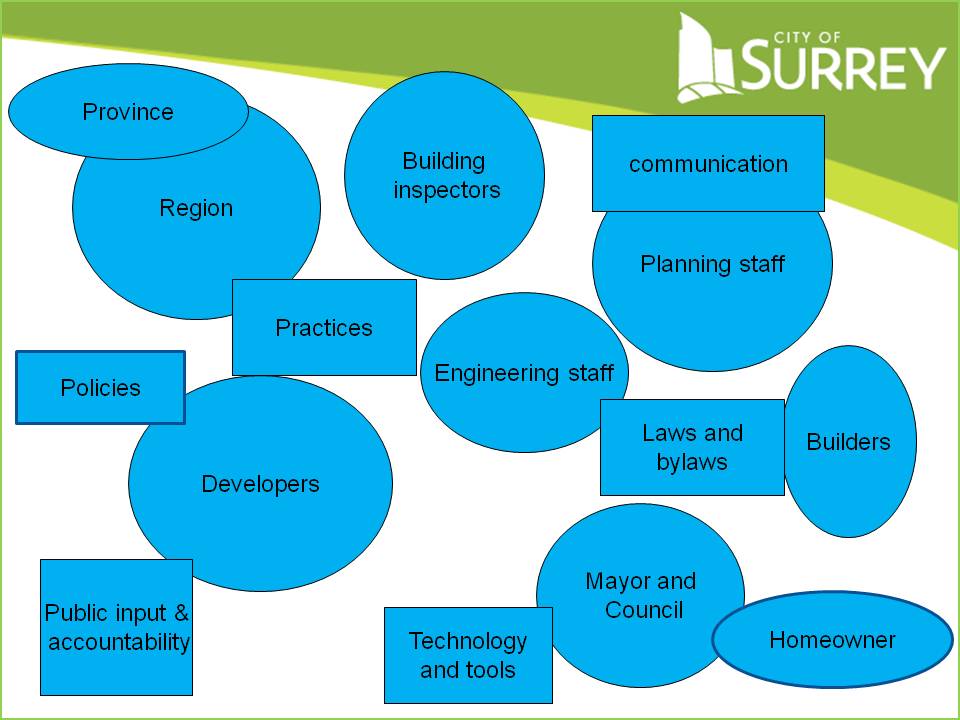SURREY FORUM STORY #6: Convening for Action in Metro Vancouver: Moving Beyond Pilot Projects to a Broader Watersheds Objectives Approach
Note to Reader:
The following web story documents what transpired at the Water Balance Model Forum hosted by the City of Surrey.
- The story is complete with links to PowerPoint presentations and YouTube video clips. Played together, these will provide viewers with the flavour of the day. The videos are especially valuable as a resource.
- To download a WORD version of the followiing web story, click on Moving Beyond Pilot Projects – Metro Vancouver Water Balance Model Forum Advances a Regional Team Approach to Green Infrastructure. The WORD version is complete with embedded links to YouTube and other Water Bucket resources.
- To read the previous five stories in this series, click on Living Water Smart and Making Green Choices in the Metro Vancouver Region.
Getting Green Infrastructure Built – City of Surrey hosted Forum in March 2009 to advance a Regional Team Approach
Moving Beyond Pilot Projects
Hosted by the City of Surrey, the Metro Vancouver Water Balance Model Forum attracted an audience of 90-plus on March 12. The Forum program was built around the HOW question as it pertains to green infrastructure:
- HOW will the City of Surrey get it built right;
- HOW will a consistent regional approach be achieved in Metro Vancouver?
The Forum was co-sponsored by the Water Balance Model Inter-Governmental Partnership and the Green Infrastructure Partnership, with a goal of moving beyond pilot projects to a watershed-based approach to achieving performance targets for rainwater management and green infrastructure.
The Forum Audience
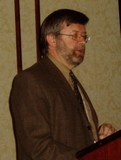 “The audience comprised a mix of Surrey staff from different departments, developers and designers who do work in Surrey, representatives from a large number of Metro Vancouver municipalities, and provincial regulators. At the end of the day, this learning event had achieved our stated objective of starting a dialogue between policy-makers and project implementers,” reports Kim Stephens, Forum team leader and Program Coordinator for the Water Sustainability Action Plan for British Columbia.
“The audience comprised a mix of Surrey staff from different departments, developers and designers who do work in Surrey, representatives from a large number of Metro Vancouver municipalities, and provincial regulators. At the end of the day, this learning event had achieved our stated objective of starting a dialogue between policy-makers and project implementers,” reports Kim Stephens, Forum team leader and Program Coordinator for the Water Sustainability Action Plan for British Columbia.
The Challenge
The Forum was undertaken as part of the implementation program for Convening for Action in British Columbia in order to promote alignment of local actions in Metro Vancouver with provincial goals as stated in Living Water Smart, BC’s Water Plan. The following challenge statement provided a frame-of-reference for advancing a consistent ‘regional team approach’ in Metro Vancouver:
How do we simultaneously work together as staff within a municipality and as a region AND externally with developers and other private sector players, to ensure we implement sustainable approaches to development?
Examples inform policy. Case studies in the morning session provided the policy people with an appreciation for what is involved in constructing green infrastructure. The afternoon session then provided the implementers with an understanding of provincial, regional and local goals…and what they are intended to achieve.
The Story of the Forum
Leading up to the Forum, a set of five stories was published on the Water Bucket Website. These tell the story of the Forum by describing the scope of each module and connecting the dots. To access downloadable versions, click on Living Water Smart and Making Green Choices in the Metro Vancouver Region.
Also, to download a concise synopsis of the Forum, including Key Messages, click on Metro Vancouver Water Balance Model Forum: Moving Beyond Pilot Projects to a Broader Watersheds Objectives Approach. This summary document is complete with a joint statement by Vincent Lalonde, Raymond Fung and Ted van der Gulik, the leaders of the three sponsoring entities. Their joint statement is reproduced below.
Joint Statement by the City of Surrey, Inter-Governmental Partnership and Green Infrastructure Partnership:
“To get to the big picture, it starts with the smallest pieces. For this reason, the Surrey Forum is advancing a regional team approach that aligns local actions with provincial policy goals as articulated in the Living Water Smart and the Green Communities initiatives Making this happen requires partnerships, collaboration, innovation and integration.”
“We see the Forum as providing an opportunity to generate positive energy in the region. In particular, the Forum will inform the actions identified in the rainwater/stormwater component of Metro Vancouver’s updated Liquid Waste Management Plan. We believe this is where the opportunity for implementing a regional team approach resides.”
“We anticipate that the Forum sharing sessions will show that there are solutions if people talk to each other about what they each could do differently. This will help all parties collaborate to more effectively fulfil their piece of the sustainable development puzzle.”
“Once we know what we want our watersheds and neighbourhoods to look like, the next step is to decide what the tools are that will get us there. All of us ….whether we are regulators, developers or designers ….need to understand and care about the goal if we are to create the future that we all want.”
Key Messages
“The Forum program was comprehensive in scope and intensive in detail,” states Kim Stephens. There was a lot for the audience to remember. So, for ease of reference, we synthesized one key message for each module: In effect, the key messages are the learning outcomes.”
- Establishing Expectations:
A decade of experience has enabled the City of Surrey to move beyond pilot projects to a broader watersheds objectives approach to rainfall capture and green infrastructure - East Clayton Lessons Learned:
Establish watershed targets that are characteristic of actual conditions, and are achievable. - Effective Implementation of Green Infrastructure – Making it Work
Getting it built right is a shared responsibility; and depends on collaboration among regulators, developers and designers. - Today’s Expectations are Tomorrow’s Standards for Green Infrastructure:
A provincial policy framework is now in place that enables municipalities to align efforts at a regional scale, make green choices, prepare communities for change, and choose to be water smart. - Making Green Choices – Opportunities for Law and Policy to Effect Change:
Policy, approved standards and legal tools can help regulators, developers and designers collaborate to ensure responsible outcomes. - Use the Water Balance Model to Inform Land Development Strategies:
Planning and water balance modeling need to be done together, and the WBM is a tool that enables integration, especially when there is a commitment to integrate land planning and green infrastructure.
 “The Forum was a success,” adds Remi Dubé, Drainage Planning Manager with the City of Surrey, and the individual responsible for developing the morning program. “We have been getting some pretty good feedback from many of the people who attended the workshop (specifically developers and consultants). It’s leading into more direct communication with certain developers who are looking at different approaches … they seemed encouraged with the dialogue that the forum appeared to promote.”
“The Forum was a success,” adds Remi Dubé, Drainage Planning Manager with the City of Surrey, and the individual responsible for developing the morning program. “We have been getting some pretty good feedback from many of the people who attended the workshop (specifically developers and consultants). It’s leading into more direct communication with certain developers who are looking at different approaches … they seemed encouraged with the dialogue that the forum appeared to promote.”
PowerPoint Presentations & Links to YouTube Videos
To both provide a record of the day and capture the flavour of presentation segments at the Forum, video clips have been selectively uploaded to YouTube. The maximum length is 10 minutes. Links to YouTube videos and associated PowerPoint presentations are listed below. You can listen to the audio track while scrolling through the corresponding PowerPoint slides.
Module 1 – Context and Overview: Establishing Expectations for a Watersheds-Based Approach
Vincent Lalonde and Ted van der Gulik opened the Forum by providing the City and inter-governmental perspectives, respectively, on the learning outcomes. To view their combined PowerPoint slides, click on Establishing Expectations. To hear what each had to say, and to view what is posted on YouTube, click on Vincent tells the City’s story and Ted explains Why an Inter-Governmental Partnership. Each video is 6 minutes.
Remi Dubé followed with an historical perspective on how drainage planning in Surrey has evolved since the 1970s, and how key neighbourhoods embody the Surrey sustainability vision. To view his PowerPoint slides, click on Historical Perspective. To hear what Remi had to say, click on Part 1 – Where We Came From and on Part 2 – Where We Are Going to access the YouTube videos.
Module 2 – East Clayton Sustainable Community: Lessons Learned On-the-Ground
The East Clayton story was presented in two parts. First David Hislop provided the sustainability context. Then Jim Dumont reviewed the implementation experience for private and public rainfall capture systems, and reflected on lessons learned. To view their respective presentation slides, first click on The Story of East Clayton and then click on Lessons Learned at East Clayton.
To hear what David had to say and be entertained, first click on Part 1 – Why a Sustainable Community in East Clayton & What are the Sustainability Principles?; and then click on Part 2 – Lessons We Have Learned. To hear what Jim had to say on the performance aspects of ‘sustainable drainage’, click on this link to What the Models Show & Overcoming Implementation Challenges.
Module 3 – Effective Implementation of Green Infrastructure: Making It Work in Surrey
This module was presented in three parts. First, James Kay told the story of Grandview Heights from the consultant’s perspective in developing the Neighbourhood Concept Plan. Then Ken Anderson provided the developer’s perspective on why “it makes good business sense” to do business differently. After that, Jim Dumont told the story of how innovation in South Newton had come about.
James Kay explained his involvement in three Neighbourhood Concept Plans that were developer-driven, and emphasized that the City challenged  the developers to meet performance criteria. To hear what James Kay had to say, click on Part 1 – Looking Back to See Where We Came From and Part 2 – How We Met the Performance Criteria for Rainfall Capture and Infiltration. “We wanted to select the measures that would provide the best value,” stated James Kay. “For example, catch basins send drainage water to infiltration trenches. We kept this system offline until after the sediment and erosion control situation had stabilized.”
the developers to meet performance criteria. To hear what James Kay had to say, click on Part 1 – Looking Back to See Where We Came From and Part 2 – How We Met the Performance Criteria for Rainfall Capture and Infiltration. “We wanted to select the measures that would provide the best value,” stated James Kay. “For example, catch basins send drainage water to infiltration trenches. We kept this system offline until after the sediment and erosion control situation had stabilized.”
Ken Anderson is the development manager for Morgan Heights community in Grandview Heights. To hear what Ken had to say about enforcement and shared 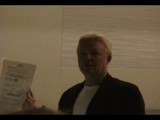 responsibility, click on Making It Happen at the Site Scale to access a 10-minute YouTube video clip. “Cash compliance is the ultimate hammer,” states Ken Anderson. “We tell the homeowners and builders upfront what we expect on the site and on the street. This requires a lot of hands-on attention and consistent enforcement to ensure consistent compliance.”
responsibility, click on Making It Happen at the Site Scale to access a 10-minute YouTube video clip. “Cash compliance is the ultimate hammer,” states Ken Anderson. “We tell the homeowners and builders upfront what we expect on the site and on the street. This requires a lot of hands-on attention and consistent enforcement to ensure consistent compliance.”
Jim Dumont followed with the South Newton story to illustrate ask a different question, get a different answer. To view Jim’s presentation slides, click on either on the Update on South Newton Experience or on the image below; and to hear what he had to say, click on Eliminating Detention Ponds to link to the YouTube video clip.
Module 4- Provincial Context: Today’s Expectations are Tomorrow’s Standards for Green Infrastructure
Module 4 provided the bridge between the morning and afternoon sessions. Members of the steering committees for the Green Infrastructure Partnership and Water Balance Model Inter-Governmental Partnership provided cascading provincial, regional and local perspectives on the policy framework for rainwater management and green infrastructure.
To view the presentation slides that provided a backdrop for this panel session, click on Today’s Expectations are Tomorrow’s Standards. To hear what everyone had to say, click on the following links to a set of YouTube video clips which are typically between two and three minutes in duration:
 Kim Stephens states the learning outcomes for the afternoon session
Kim Stephens states the learning outcomes for the afternoon session
Remi Dubé, City of Surrey Drainage Planning Manager, recaps the morning outcomes and the direction in which Surrey is heading
Ted van der Gulik describes what is coming next with the Water Balance Model
 Karen Rothe, Manager for Metro Vancouver and Regional Growth Strategies, explains the Ministry of Community Development role in promoting the right kind of development in the right place
Karen Rothe, Manager for Metro Vancouver and Regional Growth Strategies, explains the Ministry of Community Development role in promoting the right kind of development in the right place
 Corino Salomi, Area Manager, Oceans, Habitat & Enforcement Branch, Lower Fraser Area, elaborates on how the Department of Federal Fisheries & Oceans now views performance targets and determining what is achievable.
Corino Salomi, Area Manager, Oceans, Habitat & Enforcement Branch, Lower Fraser Area, elaborates on how the Department of Federal Fisheries & Oceans now views performance targets and determining what is achievable.
 Ed von Euw, Senior Engineer in the Policy and Planning Division of Metro Vancouver, provides insight into the current consultation process for updating the region’s Liquid Waste Management Plan, in particular the rainwater/stormwater component.
Ed von Euw, Senior Engineer in the Policy and Planning Division of Metro Vancouver, provides insight into the current consultation process for updating the region’s Liquid Waste Management Plan, in particular the rainwater/stormwater component.
![]() John Sidnell, representing the Master Municipal Construction Documents Association on the Green Infrastructure Partnership, describes the mandate of the MMCD committee that is developing a new specification for detention and infiltration structures.
John Sidnell, representing the Master Municipal Construction Documents Association on the Green Infrastructure Partnership, describes the mandate of the MMCD committee that is developing a new specification for detention and infiltration structures.
 Richard Boase of the District of North Vancouver, and the new Co-Chair of the Inter-Governmental Partnership, talks about the role of all Forum participants in ensuring that collectively we truly do business differently.
Richard Boase of the District of North Vancouver, and the new Co-Chair of the Inter-Governmental Partnership, talks about the role of all Forum participants in ensuring that collectively we truly do business differently.
 Paul Ham, the Past-Chair of the Green Infrastructure Partnership and Surrey’s former City Engineer, speaks about handing from the Previous Generation to the Next Generation; and emphasizes that through a learning, evolutionary process we can create a better tomorrow.
Paul Ham, the Past-Chair of the Green Infrastructure Partnership and Surrey’s former City Engineer, speaks about handing from the Previous Generation to the Next Generation; and emphasizes that through a learning, evolutionary process we can create a better tomorrow.
 Lynn Kriwoken, Director, Innovation and Planning in the Watershed Stewardship Division of the Ministry of Environment, is the Province’s lead person for delivery of Living Water Smart, BC’s Water Plan. Lynn emphasizes that the policy statement on page 43 is the lynch-pin of Living Water Smart.
Lynn Kriwoken, Director, Innovation and Planning in the Watershed Stewardship Division of the Ministry of Environment, is the Province’s lead person for delivery of Living Water Smart, BC’s Water Plan. Lynn emphasizes that the policy statement on page 43 is the lynch-pin of Living Water Smart.
The Premier’s Office has produced a 2-minute video that features Ted van der Gulik and Kim Stephens telling the story of what the Water Balance Model means for British Columbia. To view the video and learn more about “the story of the Water Balance Model”, click on this link to Premier’s Award recognizes the Water Balance Model for its innovation and excellence.
Module 5 – Making Green Choices: Opportunities for Law and Policy to Effect Change on the Ground
The purpose of Module 5 was to explore how policy and legal tools can help regulators, developers and designers collaborate to ensure responsible outcomes. Susan Rutherford of the Green Infrastructure Partnership facilitated the session; she was assisted by Sam Lau, the City’s Manager of Land Development Services.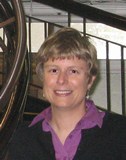
To view the set of PowerPoint slides prepared by Susan Rutherford to provide the frame-of-reference for a town hall sharing session, click on Opportunities for Law & Policy to Effect Change on the Ground. To hear what Susan Rutherford had to say when she opened the town hall sharing session, click on Shared Responsibility to link to the YouTube video (8 minutes).
 After that, and to hear Sam Lau explain the City’s processes, click on Three Processes that Ensure On-Lot Compliance (10 minute YouTube video). “Currently, building permits are not released until the on-lot infiltration systems are certified by a qualified professional engineer. This provides the City with considerable leverage to ensure compliance,” states Sam Lau.
After that, and to hear Sam Lau explain the City’s processes, click on Three Processes that Ensure On-Lot Compliance (10 minute YouTube video). “Currently, building permits are not released until the on-lot infiltration systems are certified by a qualified professional engineer. This provides the City with considerable leverage to ensure compliance,” states Sam Lau.
Module 6 – Making Green Choices: Use of the Water Balance Model to Inform Land Development Strategies
To bring the Forum storyline to a conclusion Jim Dumont framed his presentation in these terms: “When we develop or redevelop land, our  starting point should be: What do we want our neighbourhoods to look like?”
starting point should be: What do we want our neighbourhoods to look like?”
To view his PowerPoint slides, click on Making Green Choices. To hear what he had to say when he spoke to this question, first click on Part 1 – Why a Watershed Vision is Critical; and then click on Part 2 – Using the Water Balance Model.
Kim Stephens closed out the day by drawing audience attention to the Build a Vision, Create a Legacy mantra of Stormwater Planning: A Guidebook for British Columbia. A segue was provided by Jim Dumont.






